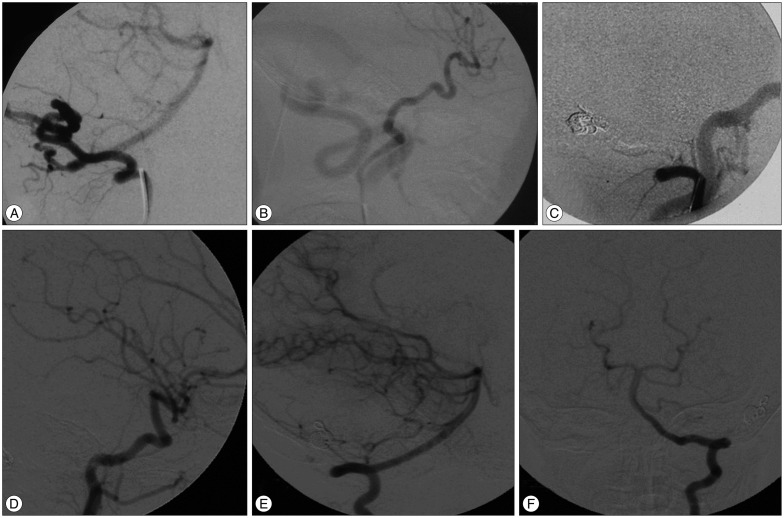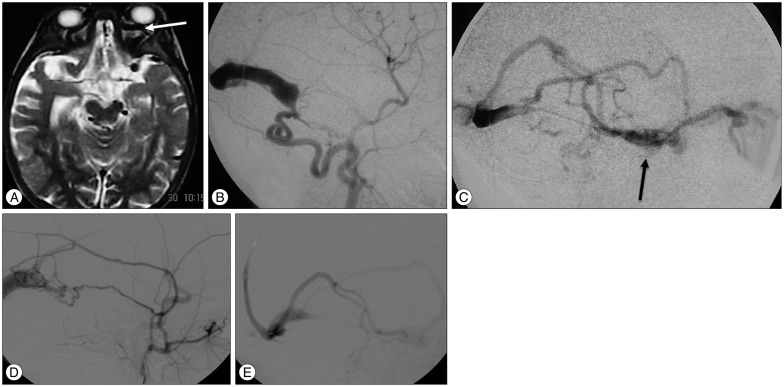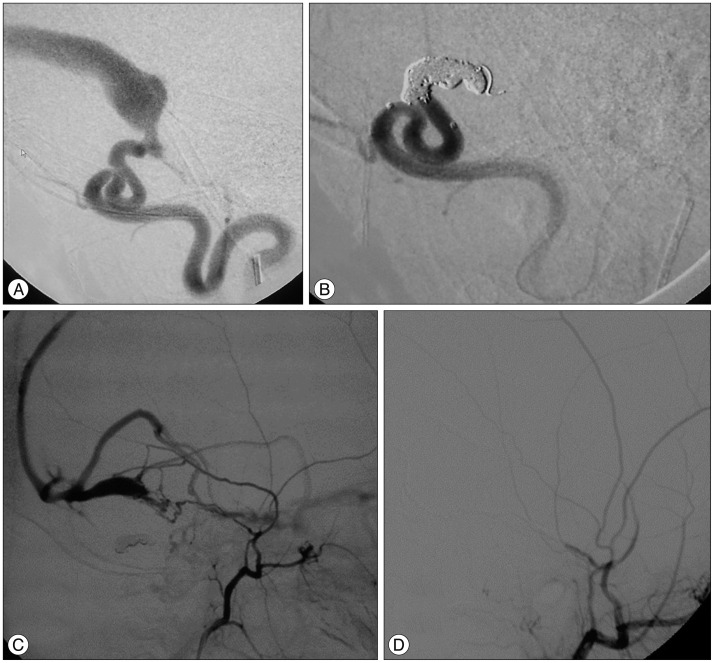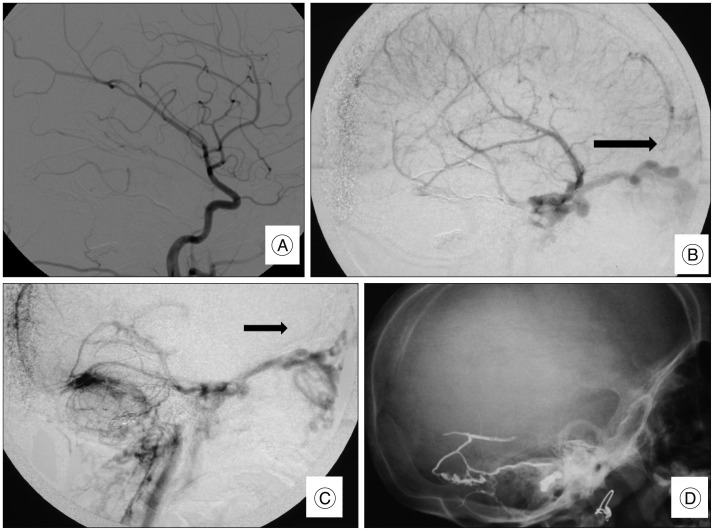1. Berenstein A, Lasjaunias PL, TerBrugge KG. Vol 3 : Clinical and Interventional Aspects in Children. Dural arteriovenous shunts. Surgical Neuroangiography. Heidelberg: Springer-Verlag Berlin Heidelberg;2006. p. 389–453.
2. Borden JA, Wu JK, Shucart WA. A proposed classification for spinal and cranial dural arteriovenous fistulous malformations and implications for treatment. J Neurosurg. 1995; 82:166–179. PMID:
7815143.

3. Cataltepe O, Berker M, Gürçay O, Erbengi A. An unusual dural arteriovenous fistula in an infant. Neuroradiology. 1993; 35:394–397. PMID:
8327121.

4. Chaudhary MY, Sachdev VP, Cho SH, Weitzner I Jr, Puljic S, Huang YP. Dural arteriovenous malformation of the major venous sinuses : an acquired lesion. AJNR Am J Neuroradiol. 1982; 3:13–19. PMID:
6800236.
5. Cognard C, Gobin YP, Pierot L, Bailly AL, Houdart E, Casasco A, et al. Cerebral dural arteriovenous fistulas : clinical and angiographic correlation with a revised classification of venous drainage. Radiology. 1995; 194:671–680. PMID:
7862961.

6. Davies MA, TerBrugge K, Willinsky R, Coyne T, Saleh J, Wallace MC. The validity of classification for the clinical presentation of intracranial dural arteriovenous fistulas. J Neurosurg. 1996; 85:830–837. PMID:
8893721.

7. Harrigan MR, Deveikis JP, Ardelt AA. Dural arteriovenous fistulas. In : Harrigan MR, Deveikis JP, editors. Handbook of Cerebrovascular Disease and Neurointerventional Technique. New York: Humana Press;2009. p. 539–560.
8. Herman JM, Spetzler RF, Bederson JB, Kurbat JM, Zabramski JM. Genesis of a dural arteriovenous malformation in a rat model. J Neurosurg. 1995; 83:539–545. PMID:
7666234.

9. Houdart E, Gobin YP, Casasco A, Aymard A, Herbreteau D, Merland JJ. A proposed angiographic classification of intracranial arteriovenous fistulae and malformations. Neuroradiology. 1993; 35:381–385. PMID:
8327118.

10. Ihn YK, Kim MJ, Shin YS, Kim BS. Dural arteriovenous fistula involving an isolated sinus treated using transarterial onyx embolization. J Korean Neurosurg Soc. 2012; 52:480–483. PMID:
23323170.

11. Liu HM, Shih HC, Huang YC, Wang YH. Posterior cranial fossa arteriovenous fistula with presenting as caroticocavernous fistula. Neuroradiology. 2001; 43:405–408. PMID:
11396747.

12. McDougall CG, Halbach VV, Dowd CF, Higashida RT, Larsen DW, Hieshima GB. Dural arteriovenous fistulas of the marginal sinus. AJNR Am J Neuroradiol. 1997; 18:1565–1572. PMID:
9296201.

13. Mironov A. Dural arteriovenous fistula of the inferior petrosal sinus producing contralateral exophthalmus. Neuroradiology. 1994; 36:619–621. PMID:
7862279.

14. Morita A, Meyer FB, Nichols DA, Patterson MC. Childhood dural arteriovenous fistulae of the posterior dural sinuses : three case reports and literature review. Neurosurgery. 1995; 37:1193–1199. discussion 1199-1200. PMID:
8584161.
15. Nakamura M, Tamaki N, Hara Y, Nagashima T. Two unusual cases of multiple dural arteriovenous fistulas. Neurosurgery. 1997; 41:288–292. discussion 292-293. PMID:
9218321.

16. Souza MP, Willinsky RA, Terbrugge KG. Intracranial dural arteriovenous shunts in children. The toronto experience. Interv Neuroradiol. 2003; 9(Suppl 2):47–52. PMID:
20591280.

17. Spittau B, Millán DS, El-Sherifi S, Hader C, Singh TP, Motschall E, et al. Dural arteriovenous fistulas of the hypoglossal canal : systematic review on imaging anatomy, clinical findings, and endovascular management. J Neurosurg. 2015; 122:883–903. PMID:
25415064.

18. Toledo MM, Wilson TJ, Dashti S, McDougall CG, Spetzler RF. Dural arteriovenous fistula associated with superior sagittal sinus occlusion secondary to invasion by a parafalcine meningioma : case report. Neurosurgery. 2010; 67:205–207. discussion 207. PMID:
20559067.
19. Wang TJ, Jou JR, Woung LC, Shih YF, Lin LLK. Ophthalmic manifestations of intracranial dural arteriovenous fistula - report of four cases. Tzu Chi Med J. 2005; 17:93–99.









 PDF
PDF ePub
ePub Citation
Citation Print
Print


 XML Download
XML Download